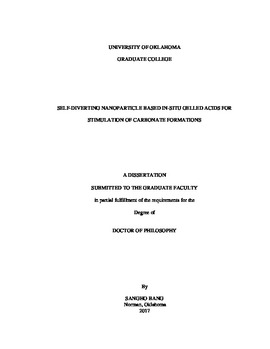| dc.description.abstract | In carbonate matrix acidizing treatment, a major challenge for the operations is to divert the injected acid from the main flow regime into a relatively lower permeability zone due to the intrinsic and unique geological and hydrogeological properties of limestones. The acid applied preferentially flows into the highest permeability zones such as vugs, natural fractures, and largest pores, when injection of acid is initiated in a carbonate formation. Thus, one of the common approaches involves applying a strong acid solution (> 10 wt %) to partially dissolve the limestone in a brief period; the so called “matrix acidizing” operations can be executed to significantly improve hydrocarbons production, or serve other purposes such as to stimulate the waste disposal injection wells to increase injectivity.
In this work, an acid-nanoparticles system has been explored to offer as a retarded acid to manipulate injectivity into high permeability zone so that the acid applied can mainly flow into the low permeability zone. The key concept of designing acid-nanoparticles formulations is to successfully create acidic gel in-situ after injecting silica nanoparticles in solution, and the resulting pseudo-solid shear-thinning gels are largely controlled by varying solution pH, particle concentration, and different types of particle and their ratios. In one example, the selected silica nanoparticles were dispersed in deionized water and blended with electrolytes, crosslinker, to modify the silica surface. A series of reaction conditions for generating stable gels were investigated and successful gel formation is strongly correlated to solution pH, concentrations of crosslinker and silica particle, and reaction temperatures. Results of silica aggregate size and zeta potential measurements also revealed the effects of surface modification by crosslinker. Furthermore, single and parallel coreflood tests were implemented to study the transport behaviors of nanoparticle-based acids in porous media. The cores used in the experiments have a permeability range of 2 to 70 md.
The crosslinker-modified silica particles effectively form gels almost instantaneously at volume fractions of SiO2 as low as 0.75 vol% at neutral pH due to aggregation into networks of silica particles. In general, gel strength drastically increases with elevated concentrations of silica and crosslinker. The rates of gelation grow substantially with increase of temperature. The net (negative) values of zeta potential of the silica particles enlarge with increasing pH when higher solution pH directly affects the surface of silica with deprotonation of surface silanol groups. In crosslinker amended solution, the silica particles develop a zeta potential within favorable window (0~-5 mv) for aggregation, eventually resulting in formation of gel networks. Results of single core pattern flooding reveal that injection of the new nanoparticle-based formulations creates multiple wormholes and flow channels using both low (2 md) and high (70 md) permeability Indiana limestone core plugs. In addition, injection of the same acid formulation is evidently diverted into the lower permeability core in the parallel setup of corefloods (combined low and high perm cores, 2 md and 70 md) experiments. Results of this study offer preliminary evidences that applying this nanoparticle-based stimulation fluid to form gels in situ is capable to successfully divert the acid into the low permeability core leading to generation of the desired multiple wormholes in both low and high permeability cores simultaneously. | en_US |
